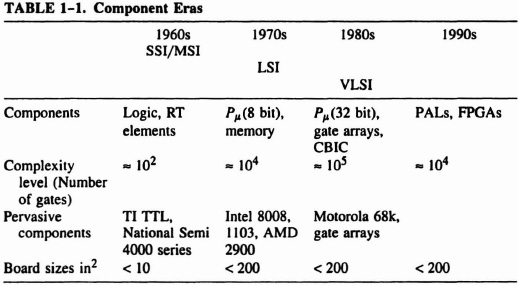1.3 IMPLEMENTATION STYLES
Although implementations of electronic systems can span a number of levels of physical hierarchy, in reality implementations in semiconductor components and boards dominate. Most of designing leads to PCBs populated with standard components. Progress in component and board technology has spawned particular implementation styles. These may be classified as in Table 1–1, which shows the SSI/MSI, LSI and VLSI eras corresponding very roughly to the last three decades.
1.3.1 Era of Early Logic Families
This era ran through the 1960s and into the 1970s. It was typified by Texas Instruments and transistor–transistor logic (TTL) [TTL88], and National Semiconductor’s 4000 series, popularly called small-scale integration (SSI) and medium-scale integration (MSI). Each provided logic in the form of gates, flip-flops, register transfer components, counters, and arithmetic-logic units (ALUs), at the chip level. At the board level, these components were used in relatively small numbers on relatively small boards to provide datapath-sized, for example, 8-bit, quantities of a particular resource, such as immediate storage (registers). Typical early logic era components are shown in Figure 1–4.


Figure 1–4. Typical early logic era components. (Photograph courtesy of P. ...
Get Field-Programmable Gate Arrays: Reconfigurable Logic for Rapid Prototyping and Implementation of Digital Systems now with the O’Reilly learning platform.
O’Reilly members experience books, live events, courses curated by job role, and more from O’Reilly and nearly 200 top publishers.

